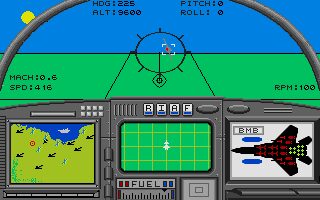
Author: Adam - Published: 4 April 2025, 1:23 pm
Leader Board Golf is a gold simulation created by Access Software originally for the Commodore 64 and released in 1986.
Leader Board redefined the sports simulation genre and introduced many players to the joys of computer golf. Behind the development were Bruce and Roger Carver, two brothers who not only programmed the game but also designed an engine that would lay the foundation for many golf games to come.
The technical ingenuity behind Leader Board was remarkable. Working within the tight constraints of the Commodore 64’s limited 64KB memory, the Carver brothers devised a clever method of rendering 3D courses. Instead of designing each hole individually, they used a set of about 30 predefined polygon shapes, referred to as “islands,” to construct the fairways, greens, and hazards. These elements were assembled to form the 18-hole courses, all floating above a sea of blue that represented water, an efficient way to manage background graphics while conserving resources. The game’s 3D perspective was rendered using the multicolor bitmap mode, which used up a significant portion of the C64’s memory, yet the result was smooth and visually impressive for the time.
Read More
Author: GN Team - Published: 4 April 2025, 12:13 pm
F-15 Strike Eagle is a combat flight simulator first released in 1984 by MicroProse for the Atari 8-bit. One year later, it was ported to Commodore 64 and Apple II. The game was designed and developed by Sid Meier, the creator of Sid Meier's Civilization.
The game marked a turning point in the world of combat flight simulators. Initially designed for the Atari 8-bit computers, the game combined action, strategy, and simulation in a way that was both accessible and engaging, setting a new benchmark for the genre.
In F-15 Strike Eagle, players take the role of a U.S. Air Force pilot flying the formidable McDonnell Douglas F-15 fighter jet. The missions are loosely based on real-world geopolitical scenarios of the time, from the Middle East to Southeast Asia, and each one involves a mix of air-to-air combat, ground strikes, and evasive maneuvers to avoid enemy SAMs and interceptors.
Read More
Author: GN Team - Published: 4 April 2025, 10:35 am
Creatures is a platform shooter developed by Apex Computer Productions for the Commodore 64 and originally released in 1990. It later arrived on the Amiga and Atari ST in 1993. The game was developed by 2 brothers: John Rowlands (programming) and Steve Rowlands (graphics and music).
In this charmingly twisted tale, you play as Clyde Radcliffe, a brave Fuzzy Wuzzy creature living on the fictional planet Blot. After fleeing a cataclysmic threat, the Blotians crash-land on Earth—unfortunately, right next to an island full of demons, their sworn enemies. The demons waste no time capturing the Fuzzy Wuzzies and locking them in deadly torture chambers. Clyde’s mission? Save his kin and outsmart the sadistic invaders.
Read More
Author: GN Team - Published: 2 April 2025, 12:41 am
Trex Warrior: 22nd Century Gladiator is a lesser-known title developed by Thalion and released in 1991 for the Amiga and Atari ST. While Thalion was better known for their graphically impressive RPGs like Amberstar and Ambermoon, as well as the fast-paced shooter Wings of Death, Trex Warrior took a different approach, blending elements of side-scrolling action with futuristic gladiatorial combat in a cyberpunk setting.
The game puts players in control of a cybernetically enhanced warrior forced to participate in brutal, high-stakes battles against increasingly dangerous opponents. Set in a dystopian future where entertainment has turned into deadly combat, Trex Warrior delivers a mix of platforming and fighting mechanics. The protagonist must navigate hostile arenas, dodging hazards, and using a variety of weapons and hand-to-hand combat techniques to take down enemies. The game’s mechanics reward precision, as button-mashing leads to quick defeats against the game's ruthless AI opponents.
Read More
Author: Adam - Published: 1 April 2025, 8:02 pm
Earthworm Jim is a 2D shooter/platformer created by Shiny Entertainment originally for the Sega Mega Drive/Genesis and published in 1994.
Earthworm Jim is one of the most eccentric and memorable platformers of the 1990s, a game that redefined the genre with its surreal humor, detailed graphics, and fluid animation. Initially developed for the Sega Genesis/Mega Drive in 1994 by Shiny Entertainment, the studio founded by David Perry, the game quickly became a hit. Perry, who had already made a name for himself with titles like Cool Spot and Disney's Aladdin for the Genesis, teamed up with artist Doug TenNapel, who designed the character of Jim, and a talented development team to create a platformer that went beyond the usual genre standards, blending frantic action, absurd situations, and high-quality visuals.
Read More
Author: Adam - Published: 1 April 2025, 2:29 pm
Lemming is a puzzle-platformer created by DMA Design and published by Psygnosis for the Amiga, DOS, and Atari ST in 1991.
Lemmings is one of the most iconic puzzle games ever created, a title that defined the genre and left an enduring legacy in gaming history. Developed by DMA Design and published by Psygnosis in 1991, the game combined innovative mechanics, charming animation, and brilliant level design to create a unique and addictive experience. The origins of Lemmings can be traced back to a simple animation experiment by Mike Dailly, who tested the Amiga's graphical capabilities with a software called Deluxe Paint, by creating a tiny, 8-pixel-tall character that could walk. This "walker" animation, featuring smooth and fluid movement, caught the attention of the rest of the DMA Design team, including Steve Hammond, Russell Kay, Gary Timmons, and David Jones, who saw the potential for a game based on these tiny creatures.
Read More